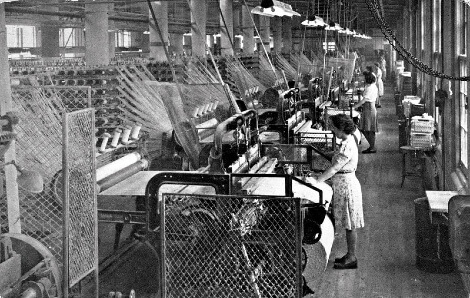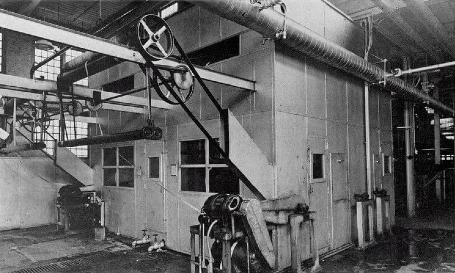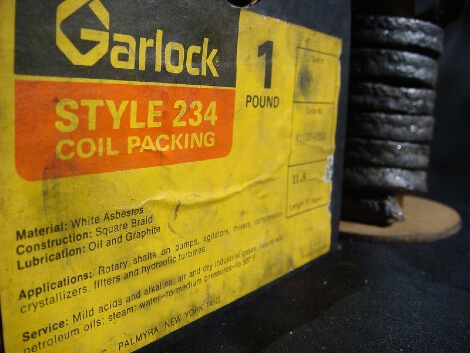Textile Mill Workers and Asbestos
Textile mill workers suffer higher rates of mesothelioma and other asbestos-related illnesses because they handled asbestos and were exposed to asbestos-containing products. Workers at asbestos textile mills also endured the highest levels of exposure because the process generated airborne asbestos fibers.

How Are Textile Mill Workers Exposed to Asbestos?

Textile mill workers who made asbestos textiles faced the highest level of exposure to asbestos because they directly handled asbestos fibers. They also worked around asbestos products used to construct mills and insulate machinery.
Those who worked in mills producing asbestos-free textiles did not directly handle asbestos fibers, but they were exposed to asbestos products installed throughout textile mills. Some of these products included asbestos gaskets, valves, packing material and insulation.
Before strict regulations on asbestos were implemented, the process of converting asbestos into usable fabric involved many different workers and locations throughout the mill. Workers moved asbestos from storage areas in the mill and mixed it with cotton. It was then piled, which meant cotton and asbestos were placed in alternating layers on the floor and then fed to a picker machine.
This step was followed by carding, the arranging of cotton and asbestos fibers in parallel rows. The asbestos cards were then spun into yarn and wound around spools. This process created an environment in which heavy asbestos exposure was possible. The material was weaved, crocheted or knitted into completely or partially finished products.

It was common for fibers to become disturbed throughout this manufacturing process. The distribution was greatest during the weaving process. Threads would rub together and produce dust and lint, which dispersed asbestos fibers into the air.
Textile mill workers were also exposed to asbestos used for insulation purposes, such as asbestos cement that insulated panels of drying machines. Weaving machinery and boilers also contained asbestos insulation. Because most machinery used to create textile products was insulated with asbestos, all textile workers who had a hand in the manufacturing of textile products were at risk of exposure.
Asbestos Products Associated with Textile Mills

Workers at mills that manufactured asbestos textiles were exposed to asbestos fibers as they combined, carded and spun asbestos fiber into yarn. Workers were exposed again when they pressed, wove, crocheted or knitted asbestos yarn into textile products.
Exposure was highest at mills where fire-resistant products were made because higher amounts of asbestos were used in these products, which included fire curtains, roofing felts, welding blankets, fireproof safety clothing, oven mitts and potholders.
Workers at mills that manufactured non-asbestos textiles were exposed to asbestos building materials, equipment parts and insulation. For example, mills were constructed with asbestos cement panels, asbestos pipes and asbestos flooring tiles. Over time these materials can degrade or sustain damage, which releases asbestos fibers into the workspace.
Fabric-weaving machinery, drying machines and boilers were insulated with different types of asbestos insulation. This equipment often contained asbestos gaskets, valves and packing material. Workers who maintained and repaired mill machinery and equipment faced the most dangerous levels of exposure.
Manufacturers of Products Textile Mill Workers Used
Manufacturers using asbestos in products for textile mills included big companies such as Johns Manville and smaller companies such as Thermoid Corp.
- Thermoid Corp.: Thermoid manufactured asbestos packing material and asbestos brakes for industrial machinery used in textile mills.
- Laclede Christy: This company made asbestos permaboard, block insulation, wire insulation and heating ducts that were installed at industrial job sites, including textile mills.
- Raymark Industries: Raymark, formerly known as Raybestos, made asbestos brakes, clutches, packing material and valves used on textile mill machinery. A spinoff company, Raytech, absorbed its asbestos liabilities.
- Johns Manville: JM manufactured many different types of asbestos products used in textile mills such as insulating boards, cement panels and floor tiles.
- Uniroyal: Uniroyal made asbestos lagging cloth that was used as wrap insulation around pipes and equipment in textile mills.
- Garlock Sealing Technologies: Garlock manufactured asbestos sheet gaskets, seals and packing material used on textile mill machinery.
- H.K. Porter Co.: Porter made asbestos brakes, gaskets, steam valves and pipes, and sold these products to industrial businesses that included textile mills.

Receive a legal guide overnight. Learn how to choose an attorney and access compensation.
Get Your Free GuideTextile Mill Workers and Mesothelioma
Scientific research on textile mill workers shows they develop asbestos-related diseases, including mesothelioma, lung cancer, ovarian cancer and asbestosis, at higher rates than the general population. According to a 2022 report by the European Commission, over 70,000 workers died in 2019 from past exposure to asbestos.
After asbestos fibers are inhaled, many are expelled, but some can become lodged in organ tissues and remain there for a lifetime. The accumulation of fibers can cause inflammation and scarring that may lead to the development of mesothelioma cancer and other asbestos-related illnesses.
If you worked at a textile mill, make sure to monitor your health and tell your doctor about your asbestos exposure history. If you develop respiratory or digestive problems, ask your doctor about asbestos cancer screenings. Diagnosing these conditions early opens up treatment possibilities that may be more effective at improving survival. Find a doctor specializing in your disease to ensure you receive the best treatment.
Several studies have documented the link between exposure to asbestos in textile mills and asbestos-related diseases.
- In 2018, a case report published in Annals of Occupational and Environmental Medicine described a 57-year-old woman who developed ovarian cancer believed to be caused by occupational exposure to asbestos. She worked in a textile mill that manufactured asbestos textiles. The woman had no family history of the disease, but she directly handled asbestos for several years while making asbestos textiles and she lived near the mill for 20 years.
- Occupational and Environmental Medicine published a study in 2017 that analyzed asbestos exposure sources among women with mesothelioma. It found the most common source of exposure was working in a non-asbestos textile mill.
- A study published in the March 2009 issue of Occupational and Environmental Medicine, titled “Lung Cancer Mortality and Fiber Exposures among North Carolina Asbestos Textile Workers,” suggests textile workers were exposed to chrysotile asbestos in at least four plants in North Carolina. It found the risk of lung cancer and asbestosis increased with cumulative exposure.
- In a 1998 study, previous records of workers from an asbestos textile, friction and packing plant in the 1970s were analyzed to determine the workers’ causes of death. The study included 2,722 men and 554 women. The results concluded that 49 men and 14 women died from lung cancer. It was also found that asbestosis and other lung diseases caused 76 deaths in men and 14 deaths in women. Mesothelioma deaths totaled 14 men and four women. With several causes of death related to asbestos exposure, this study emphasized textile mill workers’ risk of developing asbestos-related diseases.
- In a study published in 1930, Edward Merewether and Charles Price of the Merewether and Price firm in London reported that of 363 textile workers who were exposed to asbestos, 26% of those were diagnosed with asbestosis. Another 21% showed signs of the disease. It was also found that four out of five still working in the industry after 20 years had confirmed asbestosis. The prevalence of pulmonary fibrosis was so high that almost all men reaching retirement age after a working life in asbestos textiles or the manufacture of asbestos insulating materials were expected to have a related health condition.
- A study published in 1924 by Dr. W.E. Cooke, an English physician who gave asbestosis its name, reported the first case involving asbestosis. The results of an autopsy confirmed asbestosis in a 33-year-old woman who had worked in an asbestos textile factory for 13 years. His finding was published in the British Medical Journal and led to years of intensive study of asbestosis in Britain, during which hundreds of asbestos textile workers were examined. Doctors and scientists found that a quarter of the workers developed asbestos-related diseases.
Legal Options for Textile Mill Workers Exposed to Asbestos
Textile mill workers have successfully sued manufacturers of asbestos products and owners of textile mills, including Avondale Mills, Coats & Clark textile mill, DuPont, Hogansville Stark Mill, J.P. Stevens textile mill, Regal Textile, Southern Asbestos Company Mills, Southern Textile Corp. and Raymark Industries, the manufacturer of Raybestos brand asbestos cloth.
Workers who developed mesothelioma may be eligible to file personal injury lawsuits and trust fund claims. Those who lost a loved one to mesothelioma may qualify to file a wrongful death lawsuit.
- The Raytech Corporation Asbestos Personal Injury Settlement Trust began accepting claims in 2001 for illnesses arising from exposure to asbestos products manufactured by Raybestos, Raymark and other corporate affiliates. Many former textile mill workers have filed claims with this trust after developing illnesses resulting from exposure to Raymark products.
- In a July 2009 case, three plaintiffs filed civil suits in Delaware against E.I. Du Pont De Nemours and Company Inc., located in Argentina. All plaintiffs complained that while working at the Argentine textile mill from 1961 to 2002, they were exposed to high levels of asbestos and inhaled asbestos fibers daily. The plaintiffs believe they developed asbestos-related diseases as a result of DuPont’s negligence in maintaining a dangerous work environment. DuPont filed a motion to dismiss the charges, claiming the plaintiffs improperly sued DuPont instead of DuPont Argentina, where the plaintiffs resided. The lower courts ruled that these cases should be litigated in Argentina because that was where the plaintiffs lived and where they were injured.
Textile mill asbestos lawsuits are complex and should be handled by an experienced mesothelioma lawyer. Depending upon where you worked and the products you were exposed to, you may be eligible to file claims against asbestos manufacturers or the textile mills where you worked.
Recommended Reading


